Over the years, the number of PMOs (Project Management Office) has risen along with the number of projects. Nowadays, almost all companies handling projects use PMOs.
The American consultancy firm Project Management Solutions surveyed the numbers. In the year 2000, 48 per cent of companies were using PMOs in their project management.
14 years on, the number had risen to 80 per cent (see figure 1).
Since the all-time peak in 2012 (87 per cent), a number of smaller companies have eliminated their PMOs. They felt that the effort was too high and the benefit too low.
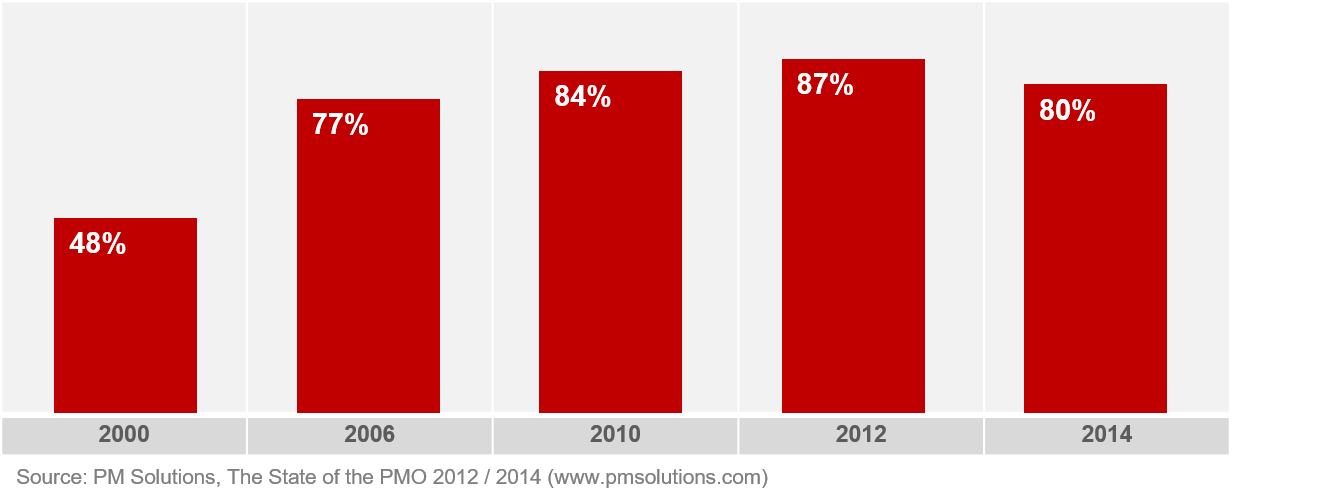
Project management is advancing fast. The number of projects is on the rise. At the same time, employees now have a higher maturity in project management.
More on the future of project management: Important PM Trends
Project management has its origins in the areas of IT and research & development (R&D). But these days, it is employed in almost all corporate sectors.
Special Download: 10 Vital PMO Success Factors (PDF file)
Please fill in the form.
* Required Fields | Data Protection
More and more undertakings that require management are implemented as projects. Starting from software migration via marketing events through to the construction of an in-house canteen.
PMO Coordinating Interdependent Project Portfolios
Project portfolios are becoming more and more interdependent. This long-term trend is going to grow even more in the coming years.
Interdependencies among projects and internationalization are on the rise. Resources are scarce. Therefore, enterprises require a unit addressing this trend. It would manage projects, recognize synergies and make use of them.
As a result, the Strategic Project Management Office (SPMO) will gain considerable importance.
Interdependencies among projects and internationalization are on the rise. Resources tend to be scarce. As a result, the Strategic Project Management Office (SPMO) will gain considerable importance.
Thanks to its position high up in the hierarchy, the SPMO reports directly to management. It manages the enterprise-wide strategic project portfolio with the necessary backing from top management.
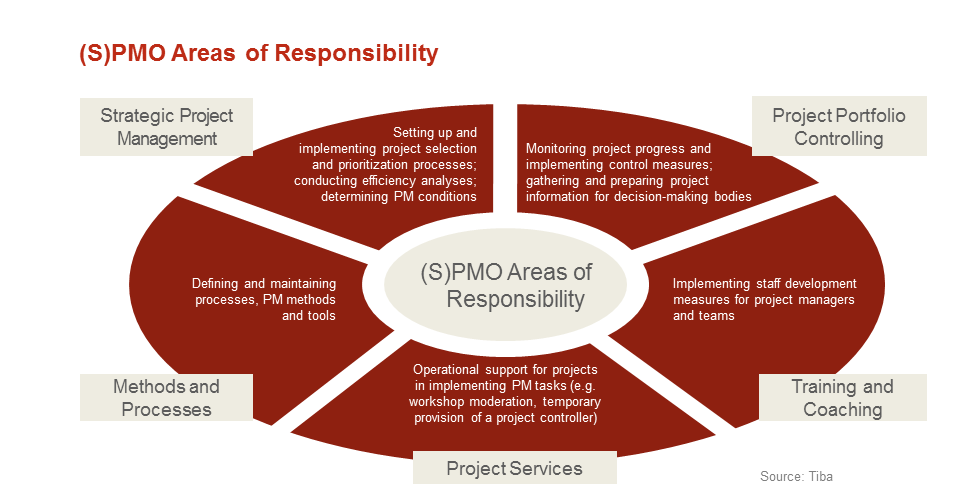
The first Project Management Offices started out on the support side. Their principal task was to support the project managers and relieve pressure on them. As a rule, they introduced tools and methods in the company.
What is more, PMOs are usually involved in the department-wide coordination of projects. Additional Project Offices (POs) attend to the management of large-scale projects.
You might also like our article about Setting Up a Successful PMO – Read now!
Special Download: How to setup a PMO in 4 simple steps (PDF file)
Please fill in the form.
* Required Fields | Data Protection
But a change is beginning to show.
Even today, PMOs face an increasing number of strategic tasks. For instance, they attend to comprehensive project control.
A further step in the development is to involve the PMO further in the strategic project management.
All project data converge, and are analyzed, in the PMO anyway. It immediately suggests itself to grant the PMO a say in strategic decisions. This would speed up project management.
All project data converge, and are analyzed, in the PMO anyway. It immediately suggests itself to grant the PMO a say in strategic decisions.
This would also eliminate a detour in decision-making. There would be no need to consult a further management level. Project management would become faster and more efficient.
Fewer Classical Support Tasks for the PMO
The PMO’s area of responsibilities will change in a further way. It will undertake fewer support tasks than is currently the case. Employees will become more and more proficient in project management.
Elaborate reports that are created manually, and prone to error, are on the decline.
Operational services of the PMO in creating project reports will decrease. This becomes possible by means of automated tool support. That is, tools integrating project management software with ERP systems or other IT environments.
This is an elementary step in the further development of project management. For the share of project management will grow and become yet more international.
An optimized toolchain will make it possible to handle resource requests with more speed and less trouble. Even if the resource is required in China and the respective PPM server is located in the Baden-Wuerttemberg city of Mannheim.
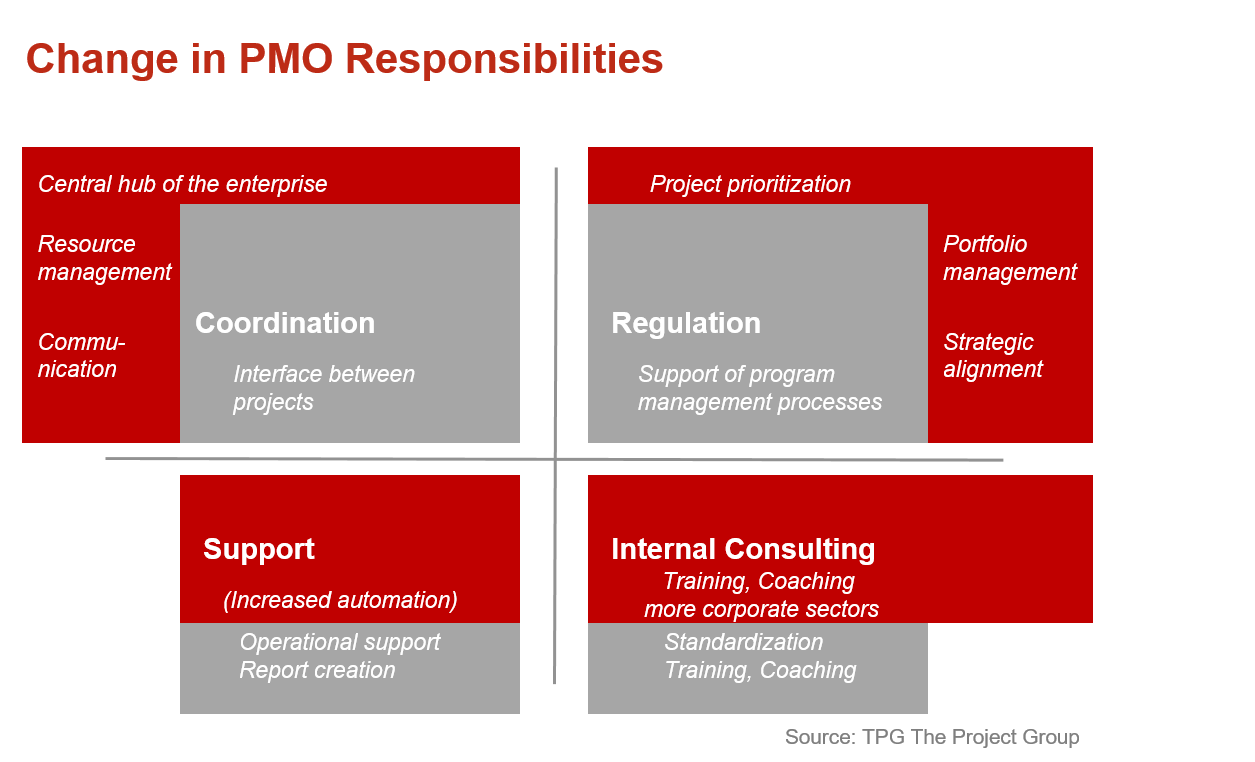
Alongside operational support, internal consulting by the PMO will recede in importance.
In the main, the PMO used to support project managers in IT and R&D by training and coaching them. Today, the demand for this kind of support has shifted to other departments, for instance marketing and human resources.
Demand for internal consulting by the PMO will go down. For employees are becoming better versed in project management themselves.
In general, demand for internal consulting by the PMO will go down. For employees are becoming better versed in project management themselves.
Future of the PMO: Project Coordination Comes to the Fore
Project coordination will witness a rising demand.
With growing complexity in program management project controlling needs to be intensified.
The PMO – hitherto the interface between projects – becomes the central hub of the enterprise. It manages the allocation of resources to the individual projects. It ensures a trouble-free project communication between all parties involved.
This article on Agile PMOs offers another approach to the future of the PMO.
If the PMO undergoes an upgrade of competencies and responsibilities, an increased amount of work is the necessary consequence.
The PMO of the future will
- synchronize strategic contributions
- prioritize projects
- coordinate the project portfolio as well as its resources
These new tasks call for adapting the PMO within the organization.
So far, it often existed alongside other organizational units. At request, it would come to the aid of:
- project managers
- department heads
- decision-makers
- the controlling department.
The directing PMO of the future has to be bolstered in its new position by higher-ranking individuals.
The directing PMO of the future has to be bolstered in its new position by higher-ranking individuals.
A PMO needs to be fully recognized and invested with the relevant competencies. Only then can it do a good job.
Looking to advance acceptance? Learn about 7 Measures to Increase PMO Acceptance.
In day-to-day project work, it is important to ensure the following:
- The PMO must obtain quick answers to its requests
- The PMO must be able to prevail where it sees a need for action
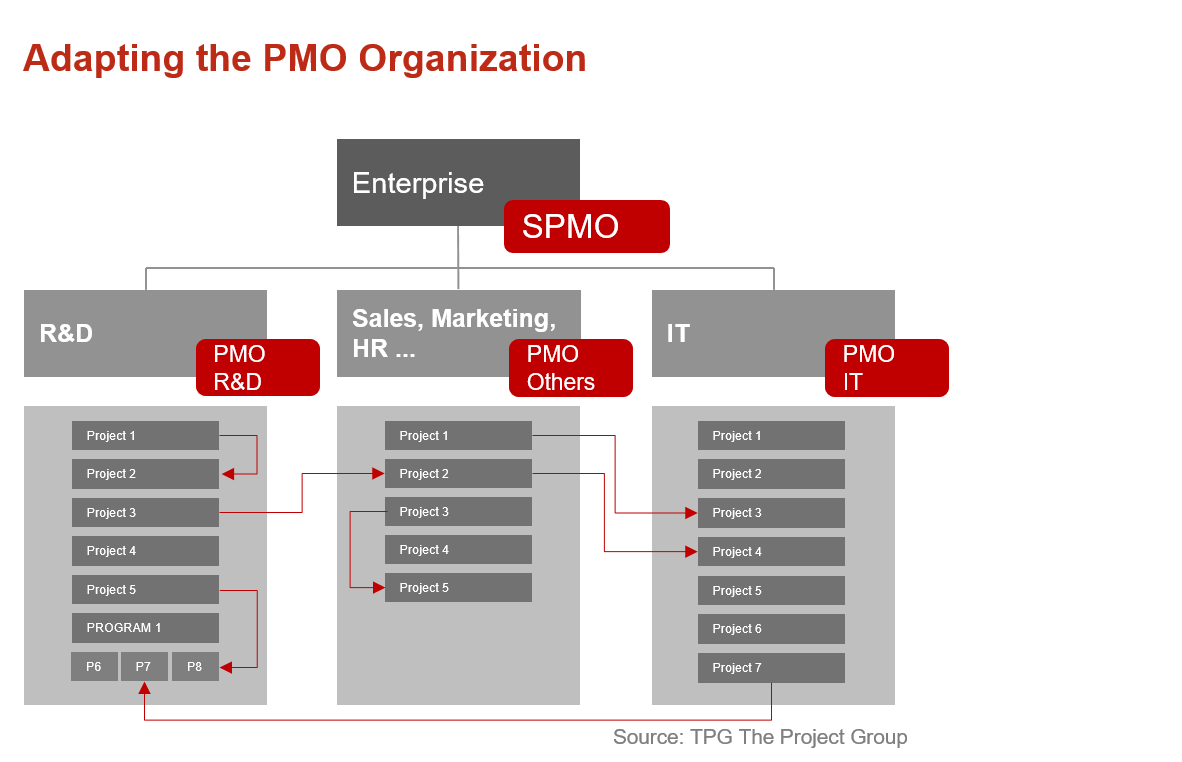
Include Decision-Makers in the PMO
Including decision-makers in the PMO is one way of adapting the PMO organization.
A C-suite employee could act as a PMO member. This would gain the PMO more powers in the prioritization of projects.
Two things are important:
- Select a person who is actually authorized to decide
- Make their PMO position part of their job description
The PMO has to assign qualified personnel to its projects at the right time. This can result in limiting the team leader’s future role to training employees. This would release team leaders from their line responsibility of project-related resource planning.
Another option would be to turn the PMO into a line position leading a team of project managers. These full-time project managers would manage large-scale projects. Whereas temporary project managers would manage the smaller projects.
This trend is already becoming apparent.
Interview with the PMO manager of a construction project – Read his views on the PMO’s role!
In many cases, there is room for improvement in the collaboration between controlling department and PMO. Deficits often prevail in the areas of project budget, planning and controlling. In this case, old rivalries can sometimes obstruct the flow of information and hamper project management.
Depending on the enterprise, the PMO of the future is evolving at a different rate.
Companies that have already established the PMO in their own ranks will develop their PMOs into strategic PMOs faster.
However, some enterprises still have a high necessity for support by the PMO. These will not be moving in the direction of a strategic PMO quite as fast.
Conclusion – PMO of the Future
Tomorrow’s Project Management Office (PMO) is the central hub of the enterprise. In terms of business hierarchy, it is close to top management. Its focus is strategic project management. The growing complexity of projects requires a higher coordination effort.
The PMO of the future coordinates the projects’ resources. For projects are becoming more and more international due to globalization. Hitherto existing operational support tasks are pushed to the background. Generating project reports becomes redundant considering the reporting tools’ growing degree of automation.
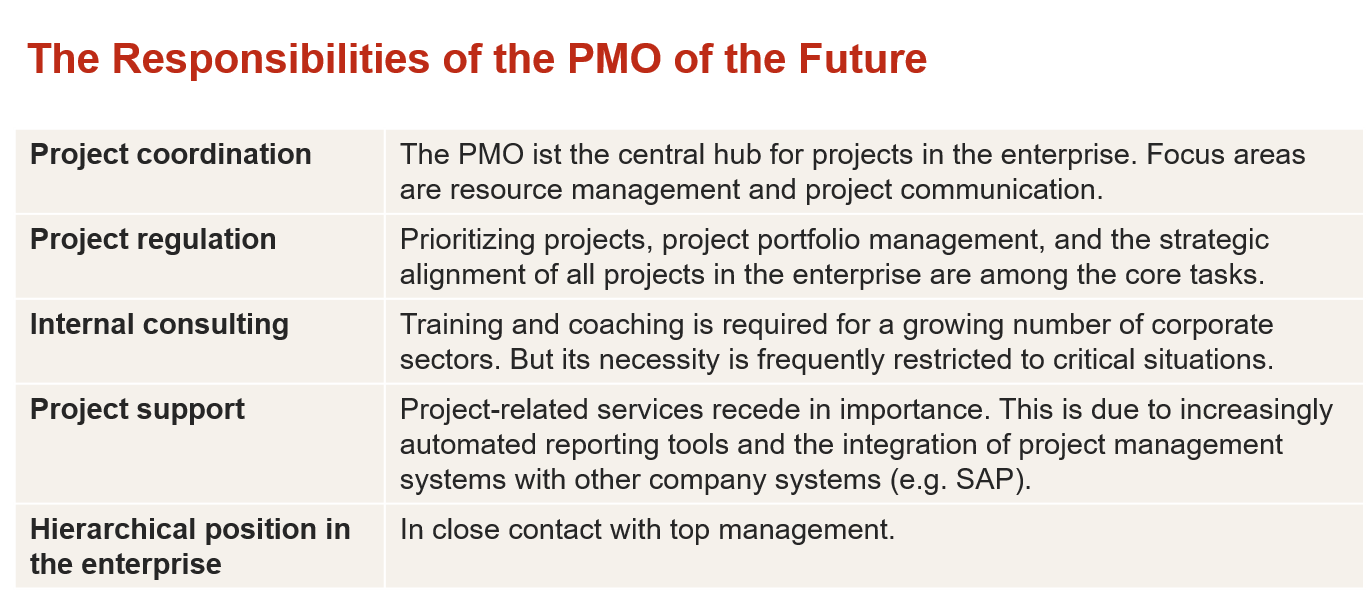
What do you think? Do you take a similar view of the development described? We would welcome your comment on this article (please enter below).
Final tip: Subscribe to the TPG Blog Newsletter now and never miss another blog post.





